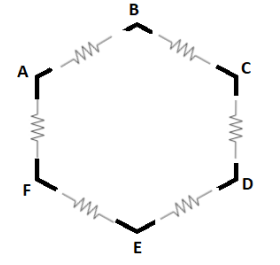Question
Question: A uniform wire of resistance \( 24\Omega \) is used to form a regular hexagon \( ABCDEFA \) . The eq...
A uniform wire of resistance 24Ω is used to form a regular hexagon ABCDEFA . The equivalent resistance of the loop between A and B is ..........Ω
(A) 4.8Ω
(B) 3.3Ω
(C) 48Ω
(D) 33Ω
Solution
Since we have a regular hexagonal structure so between A and B it will be in parallel resistance. So by using the parallel formula for the resistance, we will be able to solve this question and get to the exact answer.
Formula used
When resistance is in parallel, then
RT1=R11+R21+R31+...
Here, RT will be the equivalent resistance
And R1,R2,R3 will be the resistance connected to it in parallel.
Complete step by step solution

Since the wire is 24Ω so by doubling it back on itself. Then it will be divided into six parts and leaving 4Ω per segment.
Therefore from this, we will get a resistance of 20Ω and 4Ω . So by using the formula of resistance in parallel, we will get the equivalent resistance as
⇒RT=RA+RBRARB
Now on substituting the values, we will get
⇒RT=4+204×20
And solving the above expression, we get
⇒RT=2480
And on solving the division, we will get the equation as
⇒RT=3.33Ω
Therefore, the equivalent resistance of the loop between A and B is 3.33Ω .
Hence, the option (b) is correct.
Additional information
In a parallel circuit, the total current will be equal to the sum of the current in the single circuit whereas in a series circuit, in each of the circuits the current will be similar. In the parallel circuit the voltage across the resistor will be equal to the supply voltage whereas, in a series circuit, the total voltage drop will be the same as the supply voltage.
Note
In a parallel circuit the effective resistance will be more than the minimum value resistance but in parallel, the effective resistance is always less than the minimum value resistance. From this point we can also check if the answer we got is correct or not.
